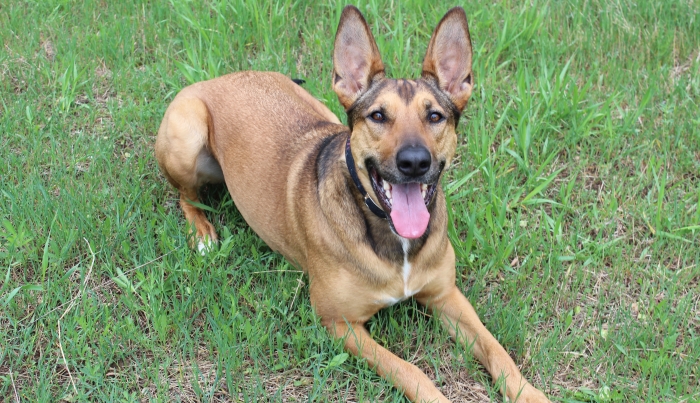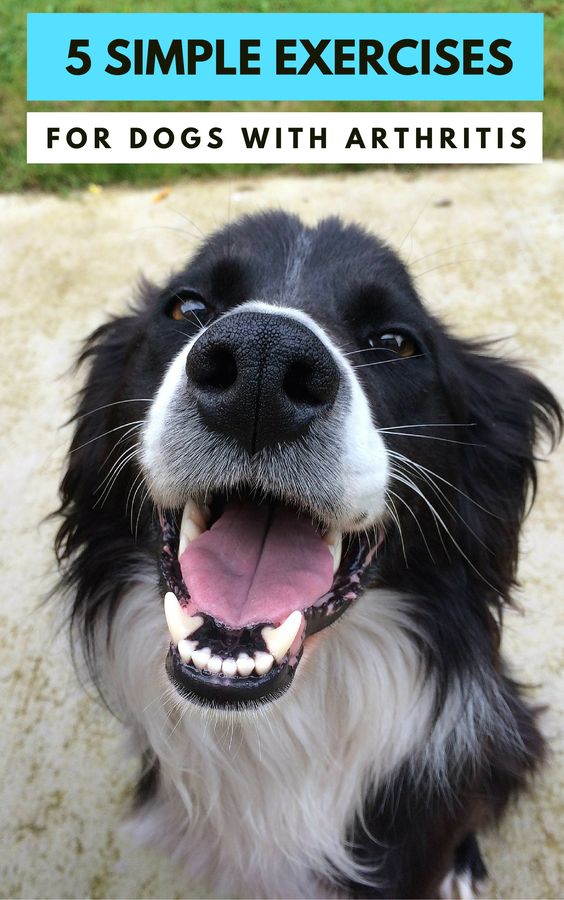How to Exercise a Dog With Arthritis
Does your dog have arthritis? My dog was diagnosed last year at the age of 3, to say I was surprised is a bit of an understatement.
An arthritis diagnosis doesn’t mean your dog can’t be active, it’s just a matter of changing up your routine. Here’s some simple tips on how to exercise a dog with arthritis.
80% of Dogs Have Arthritis By The Age of 8
By the time a dog reaches the age of 8 he has an 80% chance of having arthritis; and 20% of dogs are already showing signs of the disease by the age of 1.
By those statistics managing arthritis is something many of us dog owners will have to do at some point in our dogs lives. It’s never a diagnosis anyone wants but it doesn’t mean all the fun activities you once enjoyed are over. And while keeping your arthritic dog active might seem contradictory the right amount of exercise can help keep your dog mobile and in shape.
The Symptoms of Canine Arthritis
Do you suspect your dog might have arthritis? The most common symptoms of canine arthritis are:
- Limping (especially after exercise & at night)
- Difficulty getting up
- Lameness in legs
- Muscle atrophy (losing muscle mass)
Dogs with arthritis also tend to lick their affected limbs more often, and some can develop spinal issues that can lead to a hunched posture. If you suspect your dog may have arthritis make an appointment with your veterinarian.
So How Do You Exercise a Dog With Arthritis?
Exercising with arthritis is a balancing act; too much can cause pain, and too little makes the condition worse. Staying active will help keep your dogs muscles strong, as well as improving circulation to those achy joints. Lack of activity leads to the condition worsening, causing joints to become even more achy and stiff.
So how do you figure out what exercises you can still enjoy with your dog? Laika and I have been trying various routines trying to come up with one that doesn’t cause her discomfort or pain. There’s been a lot of trial and error, but I’m finally confident enough to say we’ve come up a pretty good (and fun) exercise routine that doesn’t leave her sore afterward. Here’s how we did it.
Consult Your Veterinarian First
If you suspect your dog has arthritis you should consult your veterinarian first. Each dog is unique, and your veterinarian will help you come up with a management plan suited for your dog. Treatment options vary depending on where your dog’s arthritis is and how severe it is. Unfortunately there isn’t a cure, but there are many ways to manage pain and discomfort associated with arthritis.
There are a wide variety of management options available. There’s physical therapy, surgery, supplements, exercise routines, anti-inflammatory drugs and pain medications. After a physical examination your vet will discuss which options are best for your dog.
Maintaining a Healthy Weight Helps With Arthritis
If your dog is overweight those extra pounds are causing extra stress on his already achy joints. Proper weight management through exercise & diet changes can help ease many arthritis symptoms.
Numerous studies have been done that show reducing weight leads to significant improvement in quality of life. Ease of activities such as climbing stairs, jumping into a car or truck, and even getting up from a sitting position can improve dramatically with weight loss. – Lawrence Veterinary Hospital
Start With a Warm Up
Many arthritic dogs are particularly stiff when they first get up. You can help them out by starting any exercise with a short, low impact walk to help get those joints moving. Most dogs move around much easier once they’ve walked around for a minute or two.
Introduce New Exercise Routines Slowly
Most of us work during the week and try and cram as much activity into our weekends as possible (aka being a weekend warrior). But when it comes to exercising your arthritic dog those sudden bursts of activity can cause added stress and injury. Try to maintain an exercise program you can do daily (or every other day), rather than one intense workout on the weekend.
5 Low Impact Exercises for Dogs With Arthritis
Just because your dog has arthritis doesn’t mean they have to stop exercising. There’s plenty of low impact activities you can still enjoy together. Here’s 5 exercises that are great for dogs with arthritis.
1. Swimming
By far the most popular exercise choice due to it’s low impact on joints. Swimming is a non weight bearing exercise that will help increase your dogs range of motion and build up muscle mass. Don’t have a regular place to go swimming? Check to see if there are any canine friendly hydrotherapy centers, pools, public beaches, or dog parks with a water feature available in your area.
2. Leash Walking
Walking around the neighborhood or at a nearby park is an easy way to keep our dogs active. It doesn’t have to be one epic walk a day either; you can take your dog on a couple shorter walks throughout the day to keep them moving.
3. Short Hikes
Try finding a trail that’s level and doesn’t have much of an incline. Depending on your dogs condition you might want to start off with a few short hikes to make sure they’re comfortable and not showing any signs of discomfort afterwards.
4. Indoor Games & Activities
Indoor games are an easy way to keep our dogs entertained and active, especially when the weather isn’t great. You can teach your dog some basic nose work such as “find the treats,” use interactive toys, or play hide and seek.
5. Short, Gentle Play Sessions
Try some short sessions of tug or fetch. Pay attention to your dog afterwards to watch for any signs of discomfort. If your dog has trouble afterwards switch up the routine to something a little gentler. Many dogs are still able to play tug in short sessions, and some can play fetch indoors if it’s on a softer surface such as carpet.
I play fetch with Laika in the living room; the carpet is a nice soft surface, and I bounce the ball rather than encouraging her to jump and catch it.
Try out a few indoor games to see which activities your dog enjoys. Watch your dog afterwards for any signs of discomfort. If your dog is achy afterwards it means they session was too long, or that the activity itself is too high impact.
Arthritic dogs don’t like to exercise, leading to more weight issues, leading to more arthritis — it’s a vicious circle. But low-impact exercise such as walking combined with a diet is extremely beneficial to arthritic pets. – Dr. Jessica Vogelsang
Avoid Running & Jumping Exercises
Dogs with arthritis should not be encouraged to jump or run around excessively. Although it’s fun to watch our dogs roughhouse and jump around it can cause those joints a lot of stress and pain later.
If your dog has arthritis avoid activities that promote a lot of jumping or running such as frisbee and long distance fetch. You may also want to discourage sitting pretty or having your dog walk on their hind legs since it causes a lot of stress on those joints.
Cool Down Period aka Massage Time
At the end of an exercise take some extra time to relax and concentrate on making your dog comfortable. Heat can help soothe achy joints so I often warm up a heating pad and put it on her hips for 10 minutes. You could also use a hot water bottle, blanket, or any of the store bought heating options available for pets – just make sure it’s not too hot before you place it on your dog.
I also give her a nice doggie massage after the heat treatment. Massages help increase the circulation to those joints and although I don’t know how much it’s helping in the long run I can tell you she really enjoys it.
Don’t Forget to Add in Some Mental Exercises
Keeping your dog fit & healthy isn’t just about adding in more physical exercise to their daily routine. All dogs can benefit from more interactive play and mental stimulation.
So throughout the day add in a few extra games and activities for your dog to enjoy in doors. A few easy ways to give your dog some more mental stimulation is by giving them a puzzle toy, a stuffed Kong, playing a game of tug or simply letting them sniff around & explore while out on your daily walk.
Find a Medication That Relieves Arthritis Pain
Unfortunately arthritis is progressive, and there will still be days when your dog shows discomfort. Even with precautions Laika still has bad days every once in a while. And on those days she gets pain relievers and plenty of rest. (and puppy massages, but that’s optional)
Glucosamine supplements are recommended for arthritic dogs, and they’re widely available at pet stores or online. They relieve inflammation and can help cartilage regeneration. Talk to your veterinarian about pain management options, and find a medication that works for your dog. Some dog’s may benefit from daily medication, while others may only need to take pain relievers on bad days.
Your Arthritic Dog Can Still Be Active & Have Fun
It might take some trial and error to find the right amount of exercise that’s right for your dog. We still go for adventures everyday and play lots of tug. Laika still swims, walks, hikes, tugs, fetches, does nose work, and plays lots of games.
Don’t dwell on what your dog can’t do; think of all the awesome activities you can still enjoy together. It took me awhile to learn that lesson. After awhile I finally realized that Laika doesn’t seem to mind her new routine at all; she’s just as happy and ready to go as she ever was. I was the one dwelling on the past and thinking of the “what ifs.” Engaging in various activities every day is keeping her happy and healthy; not the lack of previous habits.
Dogs teach us various lessons; and living for the moment is one Laika’s taught me.
Growing old is mandatory; growing up is optional. – Chili Davis
What Low Impact Exercises Does Your Dog Enjoy?
How do you exercise your arthritis dog? Do you go swimming a lot with your dog? Do you try and get in a daily walk or two? Did I miss any activities you still enjoy with your arthritic dog?
I am not a veterinarian; please consult a professional if you suspect your dog has arthritis or if you want help coming up with a management plan for the condition. It’s taken a lot of trial and error and we’ve been working closely with our vet the entire time. This post is meant for informational purposes to show that arthritic dogs can (and should) remain active.


